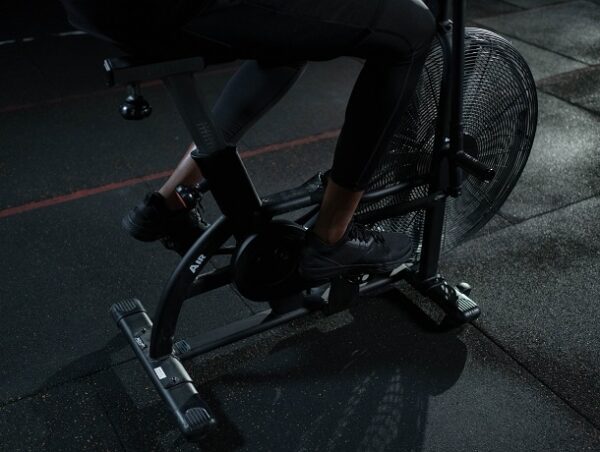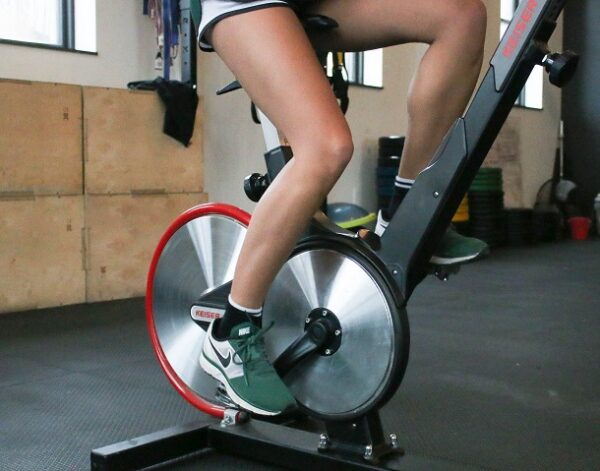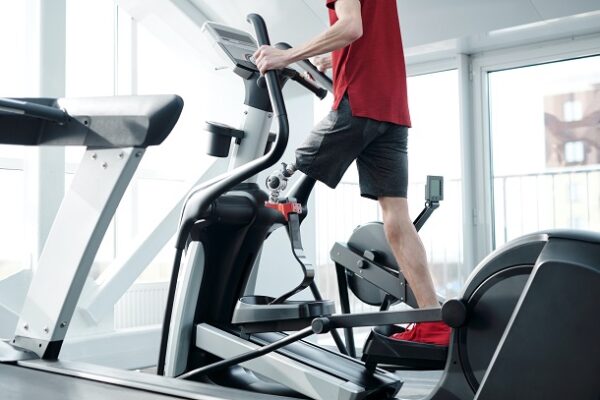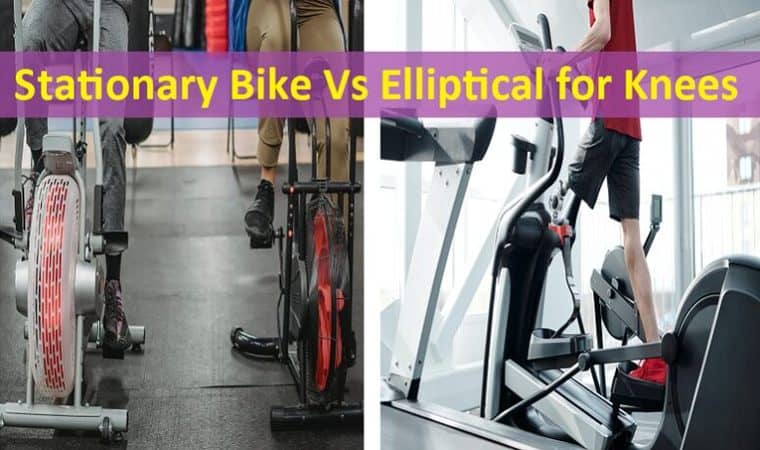Everyone has been there. You are in the gym or perhaps you are getting ready to set your own home gym. You want to tone your body, lose some fat and give your heart a good exercise, but there are lots of cardio machines out there. When building your own home gym, you will need to make a decision based on the available space.
Just like for anything else in life, your current circumstances will dictate the final decision. If you are recovering after a surgery, suffering from bad knees or you are simply aging and you feel your bones going weaker and weaker, a bit of medical research is just as important. Comparing the stationary bike vs elliptical for knees is, therefore, an important consideration in the process.
Why? Simple.
You will need to stand in order to exercise on one of them. The other one implies sitting. Plus, each fitness gadget targets different muscles too. Here is everything you need to know.
Differences between the stationary bike and elliptical machine
The stationary exercise bike is self-explanatory. It is designed and shaped like a bike, but it does not have any wheels. Basically, you can pedal for hours at different levels of intensity – you are not going anywhere. It is excellent for spinning exercises in the comfort of your home or a gym – meaning the weather is irrelevant.
The impact on joints is relatively low. According to Sage Journals, a stationary bike will improve the functionality and relieve the pain in knee osteoarthritis, meaning it is obviously just as handy in training injured or weak knees. Most bikes also come with all sorts of features and adjustments to ensure the perfect workout.
An elliptical machine is sometimes referred to as a cross trainer. It simulates the walking movement. Imagine going up on a trek – grab a couple of walking sticks and go. This is what the cross trainer feels like. You can also simulate running activities or even stair climbing. Again, the impact on your joints is relatively low. More importantly, you will also exercise your upper body due to the handles.
In terms of effectiveness, the elliptical machine will burn more calories because it stimulates both the upper and lower body.
Therefore, there is more effort required. But on the other hand, the stationary exercise bike allows you to sit down while exercising. If you have a bad knee or both of your knees feel weak, standing throughout long workouts is not a good option.

The other machine that gives you great lower body but with a tad more intensity is the pilates chair. Again, it might not be the best one to go with if you have bad knees or injury, in which case you’ll be better off using a reformer. In case you’re wondering what on earth a pilates chair or a reformer is, Fitnessbaddies have discussed both in depth, and went a step further to list some of the best picks I’ve seen on the market lately.
Pros and cons of elliptical vs bike
Comparing the stationary bike vs elliptical for knees implies understanding how each of them can help too. Apart from a top notch cardio workout, the elliptical will use your whole body. The impact is low because your feet are not meant to leave the pedals – from this point of view, treadmills are not really recommended.
Elliptical machines allow some variety too – adjust the speed or resistance or perhaps change the range of motion to target different muscles. Everything in an elliptical is connected, so you will always have the perfect form. You cannot move a leg or an arm out of rhythm. You will find your pace in no time and you simply cannot mess anything up.

The low impact is both a pro and a con. However, those with bad knees will most likely appreciate it because of less pressure on their joints. Now, on another note, the elliptical does not offer challenging features like other machines – such as an inclination. Then, the general size may not be suitable for everyone – pay attention to how it feels and make sure the movement is natural.
According to the University of Rochester Medical Center, the stationary bike is excellent for your cardiovascular fitness – a heart rate monitor will prove it. The bike will also strengthen your legs and improve your knees – all these without putting too much tension on them. You can change the speed based on how you feel, as well as the overall resistance.
Adjustments are simple and straightforward – you can usually do everything through a monitor. You do not need to wind up – like various cardio machines. You do not have to use momentum either – common when riding on public roads. In other words, based on how your knees feel, stationary bikes are excellent for long workouts or HIIT exercises.
Now, as you sit down, you do not put as much pressure on your knees. Indeed, you will still have to push into those pedals, but the pressure is way lower when compared to your body weight. All in all, the reason both of these cardio machines are considered low impact fitness gadgets because your feet do not leave the pedals.
Stationary bike vs elliptical for damaged knees
Both options will improve the range of motion in your knees, add to your endurance and strength – no pressure on your knees. However, cycling offers lower joint forces. In fact, the elliptical puts the same pressure on your knees as walking. It is not a lot, but definitely worth some consideration. With these thoughts in mind, people with serious knee problems or perhaps degenerative medical issues should stick to cycling.
Think about the body position as well. An elliptical will bear more weight than a stationary bike. The elliptical simulates walking, meaning you are supposed to stand. There will be motion in your hips, ankles and knees. You need good control of the body, as well as balance. The move is helpful – after all, this is how you use your knees day by day.

People with light knee problems will benefit from the elliptical because it strengthens them. But then, those with severe problems or injuries should stick to the stationary bike. They will no longer need to struggle standing upright. In fact, if you find yourself in this situation, you might as well consider a recumbent bike.
Different types of exercises will target different types of muscles. Both pieces of equipment will work on your knee muscles and strengthen them. It is extremely important to avoid exaggerating or you could aggravate your problems. Adjust the equipment based on your needs – resistance, range of motion and so on.
You need to start with low exercises and no discomfort at all. Slightly add more to the intensity – a bit of a challenge is desired, but there should be no pains whatsoever. Whether you increase the resistance, bend or flexion, these settings will work on your knees. This is why it pays off choosing settings that work on your muscles, but without damaging them some more.
Which is better for knees, an elliptical or a bike?
In theory, the bike is better and safer for knees. Comparing the stationary bike vs elliptical for knees implies considering your circumstances. If you have weak knees without any apparent reasons, it pays off working on your muscles a little, so an elliptical might be better. But if your weak knees are the result of injuries or medical conditions, the stationary exercise bike might be better.
If not sure, go to your local gym and try working out with each machine. Spend a couple of weeks working out on a stationary bike. Spend another few weeks exercising on an elliptical. Obviously, you have to start with low settings and work your way up, see how you feel and make a decision yourself.
Frequently asked questions
Still unsure when comparing the stationary bike vs elliptical for knees?
- Why do I have weak knees?
The general overuse – such as an exhausting job or too much exercise – is the primary cause of weak knees. Other causes may include various mechanical problems, such as muscular imbalance. Loose pieces of cartilage could also cause such problems – not to mention injuries.
- Why do my knees hurt after using elliptical?
The elliptical trainer may simulate walking, but the movement is quite unnatural because you do not walk around with sticks or hands swinging all the way to the top. This unnatural movement might contribute to the knee pain. After all, the base motion is inconsistent with the natural movement of the joint.
- Can you use an elliptical with bad knees?
Yes. The low impact activity should not cause intense pains if used correctly. It is a low impact aerobic activity.
- Does riding a stationary bike strengthen your knees?
A stationary bike can strengthen and rehabilitate the knee because it is a low impact exercise that does not bear any weight. The position is stable and controlled.
- What exercise equipment is best for knee pain?
An elliptical is a great option – not as good as a stationary bike though. The rowing machine is also a good cardio equipment with low impact on the knees, not to mention step ups.
Wrapping up
Bottom line, comparing the stationary bike vs elliptical for knees will not give you a crystal clear winner because it depends on your circumstances. In theory, the stationary bike puts less stress on weak knees, but there are situations when strengthening knees is the best solution – hence the necessity of an elliptical.
References:




